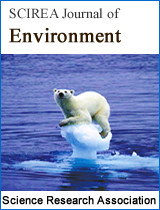Refined Numerical Simulation of Environmental Flow, Mixing and Transport in Amazon River near Manaus City by Using Multiple Depth-Averaged Two-Equation Turbulence Models and Multi-Grid Iterative Method
DOI: 480 Downloads 9292 Views
Author(s)
Abstract
This paper reports a refined numerical simulation for Amazon River, aiming to develop a mathematical model and numerical tool for modeling and predicting turbulence flows and contaminant transport in complex natural waters. In the mathematical model, the depth-averaged two-equation closure turbulence k-omega model, together with k-epsilon model and k-w model, were used to close non-simplified quasi 3D hydrodynamic fundamental governing equations. The discretized equations, however, were solved by advanced multi-grid iterative method under coarse and fine two-levels’ non-orthogonal body-fitted grids with collocated variable arrangement. Except for steady flow and transport computation, the processes of black-water inpouring and plume development, caused by the side-discharge from the Negro River, also have been numerically studied. The used three depth-averaged two-equation closure models are suitable for modeling strong mixing turbulence. The recently built k-omega turbulence model with higher order of magnitude of transported variable provides a possibility to enhance the computational precision. Based on the developed mathematical model, which can provide multiple turbulence two-equation closure models for quasi 3D modeling, a CFD software, namely Q3drm1.0 and Q3drm2.0, was developed. This numerical tool focuses on the refined numerical simulations of the steady and unsteady problems of flow and transports with the strong ability to deal with different tipes of discharges. In this paper, only the investigation of side-discharge is presented.
Keywords
depth-averaged turbulence models, river modeling, contaminant transport, turbulent mixing, grid generation with multiple islands, multi-grid iterative method
Cite this paper
Li-ren Yu, Jun Yu,
Refined Numerical Simulation of Environmental Flow, Mixing and Transport in Amazon River near Manaus City by Using Multiple Depth-Averaged Two-Equation Turbulence Models and Multi-Grid Iterative Method
, SCIREA Journal of Environment.
Volume 1, Issue 1, October 2016 | PP. 1-19.
References
| [ 1 ] | M. Choi, H. Takashi, A numerical simulation of lake currents and characteristics of salinity changes in the freshening process, J. Japan Society of Hydrology and Water Resources, 13 (2000) 439-452. (in Japanese) |
| [ 2 ] | M. Lunis, V.I. Mamchuk, V.T. Movchan, L.A. Romanyuk, E.A. Shkvar, Algebraic models of turbulent viscosity and heat transfer in analysis of near-wall turbulent flows, International J. of Fluid Mechanics Research, 31 (2004) 60-74. http://dx.doi.org/doi/10.1615/InterJFluidMechRes.v31.i3.60 |
| [ 3 ] | E. Viparelli, O.E. Sequeiros, A. Cantelli, P.R. Wilcock, G. Parker, River morphodynamics with creation/consumption of grain size stratigraphy 2: numerical model, Journal of Hydraulic Research. 48 (2010) 727-741. http://dx.doi.org/doi/doi:10.1080/00221686.2010.526759 |
| [ 4 ] | W. Rodi, R.N. Pavlovic, S.K. Srivatsa, Prediction of flow pollutant spreading in rivers, In: H.B. Fischer (ed.), Transport Models for Inland and Coastal Waters, University of California Academic Press, 1980, pp. 63-111. |
| [ 5 ] | L. Cea, L. Pena, J. Puertas, M.E. Vázquez-Cendón ME, E. Peña, Application of several depth-averaged turbulence models to simulate flow in vertical slot fishways, J. Hydraulic Engineering. 133 (2007) 160-172. http://dx.doi.org/doi/10.1061/(ASCE)0733-9429(2007)133:2(160) |
| [ 6 ] | I. Kimura, W.S.J. Uijttewaal, T. Hosoda, M.S. Ali, URANS computations of shallow grid turbulence. J. Hydraulic Engineering, 135 (2009) 118-131. http://dx.doi.org/doi/10.1061/(ASCE)0733-9429(2009)135:2(118) |
| [ 7 ] | J.T. Lee, H.C. Chan, C.K. Huang, Y.M. Wang, W.C. Huang, A depth-averaged two-dimensional model for flow around permeable pile groins, International J. the Physical Sciences. 6 (2011) 1379-1387. http://dx.doi.org/doi/10.5897/IJPS11.078 |
| [ 8 ] | http://www.cfd-online.com/Wiki/Turbulence_modeling |
| [ 9 ] | P.G. Saffman, A model for inhomogeneous turbulent flow, Proc. Roy. Soc., A317 (1970) 417-433. |
| [ 10 ] | D.C. Wilcox, Turbulence Modeling for CFD, La Canada, DCW Industries, Inc., 1998. |
| [ 11 ] | J.H. Ferziger, M. Peric, Computational Methods for Fluid Dynamics, 3rd ed., Berlin, 2002. |
| [ 12 ] | A. Riasi, A. Nourbakhsh, M. Raisee, Unsteady turbulent pipe flow due to water hammer using k–ω turbulence model, J. of Hydraulic Research. 47 (2009) 429-437. http://dx.doi.org/doi/ 10.1080/00221681003726247 |
| [ 13 ] | L.R. Yu, J. Yu, Numerical research on flow and thermal transport in cooling pool of electrical power station using three depth-averaged turbulence models, Water Science and Engineering, 2(2009) 1-12. http://dx.doi.org/doi/10.3882/j.issn.1674-2370.2009.03.001 |
| [ 14 ] | J.J. McGuirk, W. Rodi, A Depth-Averaged Mathematical Model for Side Discharges into Open Channel Flow, SFB 80/T/88, Universität Karlsruhe, 1977. |
| [ 15 ] | L.R. Yu, S.N. Zhang, A new depth-averaged two-equation ( ) turbulent closure model, J. of Hydrodynamics B1 (1989) 47-54. |
| [ 16 ] | J.O. Ilegbusi, D.B. Spalding, Application of a New Version of the k-w Model of Turbulence to a Boundary Layer with Mass Transfer, CFD/82/15, Imperial College, 1982. |
| [ 17 ] | L.R. Yu, A.M. Righetto, Depth-averaged turbulence model and applications, Advances in Engineering Software, 32 (2001) 375-394. http://dx.doi.org/doi/10.1016/S0965-9978(00)00100-9 |

